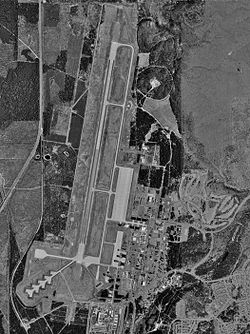K.I. Sawyer AFB, Michigan
| K. I. Sawyer Air Force Base | |
|---|---|
| Part of Strategic Air Command | |
| Marquette County, near Marquette, Michigan | |

28 April 1998
|
|
|
Location in Michigan
|
|
| Coordinates | 46°21′13″N 87°23′43″W / 46.35361°N 87.39528°WCoordinates: 46°21′13″N 87°23′43″W / 46.35361°N 87.39528°W |
| Type | Air Force Base |
| Site information | |
| Controlled by | U.S. Air Force |
| Site history | |
| Built | 1944 |
| In use | 1955–95 |
| Events | Cold War |
| Garrison information | |
| Garrison | 410th Bomb Wing |
| Airfield information | |||||||||||
|---|---|---|---|---|---|---|---|---|---|---|---|
| Summary | |||||||||||
| Elevation AMSL | 1,221 ft / 372 m | ||||||||||
| Coordinates | 46°21′13″N 087°23′43″W / 46.35361°N 87.39528°W | ||||||||||
| Runways | |||||||||||
|
|||||||||||
K. I. Sawyer Air Force Base is a decommissioned U.S. Air Force installation in Marquette County, Michigan, south of the city of Marquette. Near the center of Michigan's Upper Peninsula, the base operated for nearly forty years and closed in 1995. The county airport, Sawyer International, now occupies a portion of the base and has scheduled airline flights and some general aviation activity. The area of the former base is now an unincorporated community and a census-designated place for statistical purposes known as K. I. Sawyer AFB
The origins of K. I. Sawyer Air Force Base begin in the mid-1930s when Kenneth Ingalls Sawyer (1884–1944), a civil engineer and Marquette County road commissioner, desired to build an airport which would aid the development of the Marquette area. The one factor which most likely influenced the establishment and final location of the airport was the growing mining industry in the local area. As the demand for iron ore increased, the need for travel increased. By 1937, the demand reached a point of air service necessity. To support this demand, a county airport was built southwest of Marquette, northeast of Negaunee.
The population of the area continued to grow, and, by 1940, Sawyer realized the new Negaunee airport could not handle its ever-increasing demands. Therefore, in 1941, the then-superintendent of the county highway department stepped out of his role and presented a plan for a new airport. The most significant landmarks on his proposed site were a hill of sand and a wealth of blueberry patches. The board agreed with the idea. Shortly thereafter, the United States was drawn into World War II. Local concern for the protection of the Great Lakes inter-lake navigation locks named Soo Locks at the trans-border area of Sault Ste. Marie prompted area citizens to propose that the U.S. Army Air Forces take over the new airfield. At that time, the proposal was shelved.
...
Wikipedia


